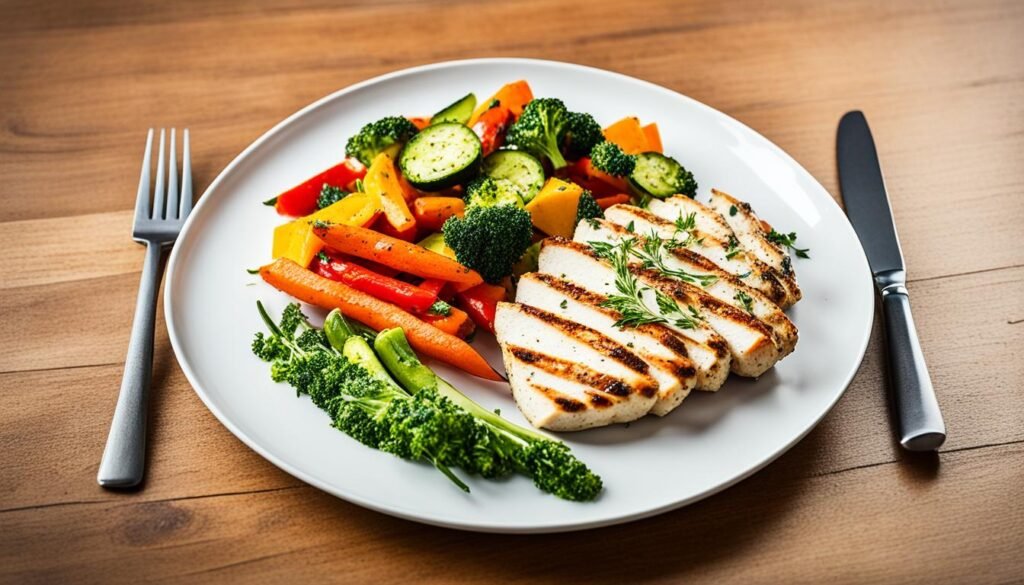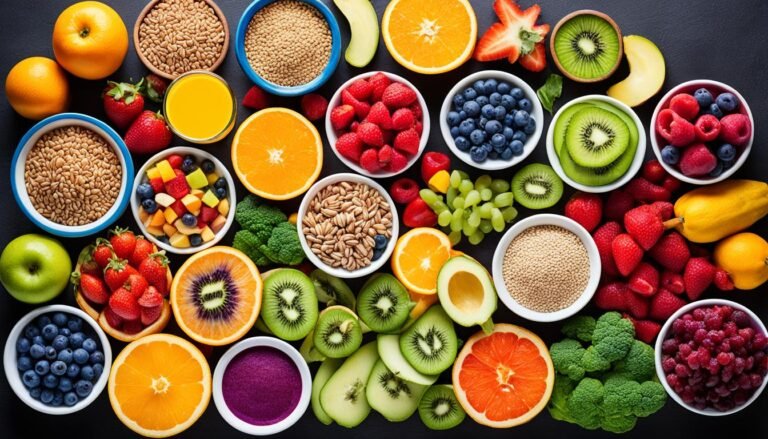What is the 30 day strict diet?
Starting a journey to be healthier often makes us think about what we eat. It’s hard to find a diet that works without leaving us hungry all the time. The 30 day strict diet, or Whole30 diet, is different. It helps you see food in a new way and promises real changes.
Created in 2009 by two sports nutritionists, the 30-day elimination diet focuses on cutting out certain foods. You won’t eat sugar, grains, legumes, dairy, and processed foods for a month. This helps find out if you have any food allergies and can lead to losing weight and more energy.
The 30 day strict diet isn’t easy, but it’s very rewarding. It’s a way of eating that comes from Nigeria but is helping people all over the world. It’s about focusing on whole foods to get healthier inside and out.
Key Takeaways
- The 30 day strict diet, also known as the Whole30 diet, is a 30-day elimination diet that removes sugar, grains, legumes, dairy, and processed foods.
- The goal of the diet is to help individuals reset their metabolism and reshape their relationship with food.
- Many people follow the 30 day strict diet in an effort to lose weight, identify food intolerances, and achieve various health benefits.
- The diet is based on the principle of strictly adhering to the rules for 30 consecutive days, without any cheating or slipping up.
- The 30 day strict diet has gained popularity as a weight loss program and clean eating diet that can potentially lead to improved energy, reduced cravings, and a healthier lifestyle.
Introduction to the 30 Day Strict Diet
The Whole30 diet, lasting 30 days, cuts out many foods. You won’t eat sugar, grains, legumes, dairy, or processed foods. It aims to help your body heal from possible negative food effects and boost your long-term health. This diet isn’t about counting calories or weighing yourself. Instead, it’s about sticking to the diet’s rules and guidelines for a full month.
Overview of the Diet
The Whole30 is a 30-day elimination program. It makes you take out specific food groups from your meals completely. By doing this, you might find out if you have any food intolerances. You’ll eat meat, seafood, eggs, fruits, veggies, and healthy fats. The goal is to help you improve your relationship with food. This means you could feel better overall by the end of the 30 days.
Benefits of Following the Diet
People say the Whole30 diet makes them lose fat, have more energy, better sleep, and fewer food urges. They also claim it improves how they feel about food. But, making these reported health effects permanent needs more research. We don’t know everything about the Whole30 diet’s long-term effects. Improving health by this diet might have some merit, but it’s wise to remember the full story is not yet clear.
What is the 30 day strict diet?
The Whole30 diet is a month-long program with strict rules. Those who join must follow these rules for 30 days. Knowing the principles of the diet is key to doing it right and getting the best results.
Principles and Rules of the Diet
To do the Whole30 diet, you must cut out sugar, grains, legumes, dairy, and processed foods. You should eat only whole, simple foods like meat, eggs, fruits, and vegetables. This diet also says not to check your weight or measurements for 30 days, excluding the first and last days. And remember, no cheating is allowed. If you do, you have to start over.
Foods Allowed and Prohibited
This diet allows foods like meats, eggs, and lots of fruits and veggies. You can also use certain types of oils. But, you can’t have sugar, grains, legumes, dairy, alcohol, or some food additives.

By sticking to these rules, people on this diet hope to refresh their bodies. This approach can help find out if there are foods your body doesn’t like. The goal is to eat foods that are good for you, leading to better health over time.
How to Follow the 30 Day Strict Diet
Getting started with the 30 day strict diet, or Whole30, means getting your kitchen ready. Toss out what you shouldn’t eat and fill your shelves with the right stuff. This includes meats, fruits, veggies, nuts, and good fats. Plan your meals and time for shopping and cooking to stay on track.
Meal Ideas and Recipes
The Whole30 is all about eating whole, less processed food. Here are some meal ideas:
- Breakfast: Hash with eggs, potatoes, and ground beef; avocado-banana smoothie; fried egg “sandwich” on a Portobello mushroom cap
- Lunch: Chicken salad with homemade mayo over greens; shrimp in red pepper sauce over zucchini noodles; bunless burger with a side salad
- Dinner: Chili made with beef and sweet potatoes; baked fish and roasted vegetables; roast chicken with a side salad
Tips for Success
To make it through the Whole30, keep a few things in mind:
- Plan what you’ll eat to help you stick to the diet
- Fill your pantry with the right foods for easy cooking
- Get friends and family to cheer you on and keep you on track
- Remove foods you can’t have to stop cravings
- It’ll take time, but stay with it as your body adjusts
- Pay attention to how your body responds to what you eat
With the right prep and meal options, plus these tips, you’re set to complete and benefit from the Whole30.

The Elimination Phase
In the Whole30 diet, the elimination phase is key. You remove certain food groups for 30 days. These are sugar, grains, legumes, dairy, and alcohol.
This Whole30 elimination phase aims to reset your body. By not eating these foods, you allow your body to recover. This helps see what foods affect you poorly.
Monitoring Your Body’s Reactions
During the Whole30 diet, watch how your body changes. Notice changes in energy, sleep, and skin. Keep a record to figure out which foods may not suit you.
The Reintroduction Phase
After 30 days of avoiding certain foods on the Whole30 diet, it’s time to add them back. You do this slowly to see if any make you feel bad. This phase is really important. It helps you find out if some foods don’t agree with you.
Gradually Reintroducing Foods
Start by adding one food group back to your meals. See how it makes you feel. Then, move to the next group. This way, you can figure out which ones your body likes best. Start with dairy, then try grains, and finally legumes, making sure to wait a few days between each group.
Identifying Potential Intolerances
Adding foods back one by one and watching how you react helps. Look out for signs like bloating, trouble with digestion, skin issues, or feeling tired. This step will show you which foods might not be good for you. It guides what you eat in the future.
Potential Benefits and Drawbacks
The Whole30 diet is known for many health perks if you are ready to follow its strict rules. It can lead to
weight loss and less fat,
better
energy and sleep,
and
less desire for unhealthy food with a healthier view on eating
. Fans of Whole30 also say it helps with
better sports performance
, and
improves inflammation and stomach troubles.
However, there’s little solid proof from science yet on these benefits. More research is needed to confirm what Whole30 really does for health.
Reported Health Benefits
Many fans share the good the Whole30 has done for them. Still, we need more research to really know its effects. The program’s full impact on our health is still a question.
Criticism and Challenges
While Whole30 is loved by some, it also gets some heat. Its strictness can be tough, making some feel they are missing out. Plus, cutting out whole food groups might not help everyone and could cause
nutrient problems
What’s more, we don’t know how well the diet works in the long run or how it affects our health on a bigger scale. Some worry that the program’s strong focus on weight and body shape might lead to
bad eating habits
Conclusion
The Whole30 diet lasts 30 days and aims to refresh your body. It cuts out certain foods for a month to help you feel better. This diet could make you lose weight, feel more energetic, and better understand food. Although it’s gotten popular, there isn’t a lot of proof it works well in the long run. But, focusing on fresh, unprocessed foods is good for many people’s health.
Think about what you learned from doing the Whole30 diet. Did your energy or sleep improve? Did it change how you see food? You might have found foods that don’t agree with you during the part where you slowly add them back. No matter what you noticed, this diet can help you understand how different foods affect you.
Decide to try the Whole30 based on what you want and need. It might not be for everyone, but it’s a strong way to change how you eat and maybe find out what foods bother you. Always pay attention to how your body reacts and choose what’s best for your health and joy in the long run.






